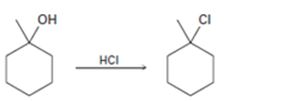
Concept explainers
a)

Interpretation:
The complete mechanism for the conversion of 30 alcohol given to 30
Concept introduction:
Alcohols get protonated in the presence of strong acids. The protonated intermediate will lose a molecule of water to yield a carbocation. The nucleophilic attack by the halide ion will lead to the formation of the alkyl halide.
To propose:
The complete mechanism for the conversion of 30 alcohol given to 30 alkyl halide by treating with HCl involving two cationic intermediates.
b)

Interpretation:
The complete mechanism for the conversion of 30 alcohol given to 30 alkyl halide by treating with HBr involving two cationic intermediates is to be proposed.
Concept introduction:
Alcohols get protonated in the presence of strong acids. The protonated intermediate will lose a molecule of water to yield a carbocation. The nucleophilic attack by the halide ion will lead to the formation of the alkyl halide.
To propose:
The complete mechanism for the conversion of 30 alcohol given to 30 alkyl halide by treating with HBr involving two cationic intermediates.
c)

Interpretation:
The complete mechanism for the conversion of 30 alcohol given to 30 alkyl halide by treating with HCl involving two cationic intermediates is to be proposed.
Concept introduction:
Alcohols get protonated in the presence of strong acids. The protonated intermediate will lose a molecule of water to yield a carbocation. The nucleophilic attack by the halide ion will lead to the formation of the alkyl halide.
To propose:
The complete mechanism for the conversion of 30 alcohol given to 30 alkyl halide by treating with HCl involving two cationic intermediates.
Trending nowThis is a popular solution!

Chapter 17 Solutions
Study Guide with Student Solutions Manual for McMurry's Organic Chemistry, 9th
- Use diagram to answer the following: 1.Is the overall rxn endo- or exothermic. Explain briefly your answer____________________2. How many steps in this mechanism?_____________3. Which is the rate determining step? Explain briefly your answer____________________4. Identify (circle and label) the reactants,the products and intermediate (Is a Cation, Anion, or a Radical?) Please explain and provide full understanding.arrow_forwardDraw the entire mechanism and add Curved Arrows to show clearly how electrons areredistributed in the process. Please explain and provide steps clearly.arrow_forward15) Create Lewis structure Br Brarrow_forward
- LIOT S How would you make 200. mL of a 0.5 M solution of CuSO4 5H2O from solid copper (II) sulfate? View Rubricarrow_forwardSteps and explantions pleasearrow_forwardMatch the denticity to the ligand. Water monodentate ✓ C₂O2 bidentate H₂NCH₂NHCH2NH2 bidentate x EDTA hexadentate Question 12 Partially correct Mark 2 out of 2 Flag question Provide the required information for the coordination compound shown below: Na NC-Ag-CN] Number of ligands: 20 Coordination number: 2✔ Geometry: linear Oxidation state of transition metal ion: +3 x in 12 correct out of 2 question Provide the required information for the coordination compound shown below. Na NC-Ag-CN] Number of ligands: 20 Coordination number: 2 Geometry: linear 0 Oxidation state of transition metal ion: +3Xarrow_forward
- Can you explain step by step behind what the synthetic strategy would be?arrow_forwardPlease explain step by step in detail the reasoning behind this problem/approach/and answer. thank you!arrow_forward2. Predict the product(s) that forms and explain why it forms. Assume that any necessary catalytic acid is present. .OH HO H₂N OHarrow_forward
